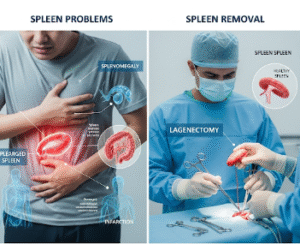Overview
Diffuse Axonal Injury (DAI) is a severe type of traumatic brain injury (TBI) that occurs when the brain rapidly shifts inside the skull, causing widespread tearing of nerve fibers (axons). This condition is common in high-speed accidents, such as motor vehicle crashes, falls, or sports-related injuries. In Korea, with its advanced neurosurgical facilities, trauma centers, and neuro-rehabilitation programs, patients with DAI receive comprehensive care that improves survival and long-term recovery.
What is Diffuse Axonal Injury?
DAI is characterized by widespread microscopic damage to the brain’s white matter, particularly in areas like the corpus callosum, brainstem, and cerebral hemispheres. Unlike focal brain injuries (such as hematomas), DAI involves scattered lesions across multiple brain regions, making it a severe and often life-threatening condition.
Symptoms
Symptoms of DAI depend on severity:
- Mild cases: brief loss of consciousness, confusion, memory issues, dizziness
- Moderate to severe cases:
- Prolonged loss of consciousness or coma
- Vegetative state or minimally conscious state
- Abnormal posturing
- Seizures
- Cognitive and motor impairments upon regaining consciousness
- Speech and behavioral changes
Causes
- High-speed motor vehicle accidents
- Falls from significant heights
- Sports injuries involving violent head impact
- Physical assaults or shaken baby syndrome
Risk Factors
- Engaging in high-risk activities (motorcycling, extreme sports)
- Lack of helmet use in biking or construction
- Older adults prone to falls
- Alcohol or drug-related accidents
Complications
- Prolonged coma or vegetative state
- Severe cognitive impairment (memory, learning, reasoning difficulties)
- Motor dysfunctions (paralysis, spasticity, coordination issues)
- Speech and communication problems
- Psychological disorders (depression, anxiety, behavioral changes)
- Long-term disability and dependence on caregivers
Prevention
- Helmet use while driving motorcycles, biking, or working in hazardous environments
- Seatbelt compliance to reduce car accident-related brain trauma
- Fall prevention strategies in elderly populations
- Strict sports safety regulations
Treatment Options in Korea
Diagnosis
Korean hospitals use advanced imaging and neurological assessments:
- MRI (Magnetic Resonance Imaging): most sensitive for detecting axonal damage
- CT scans: to identify associated hemorrhage or swelling
- Neurological exams & Glasgow Coma Scale (GCS): to assess severity
- Electroencephalogram (EEG): to detect seizure activity
Medical Treatments
- Intensive care unit (ICU) monitoring for severe cases
- Mechanical ventilation if respiratory function is compromised
- Medications to reduce brain swelling (mannitol, hypertonic saline)
- Anti-seizure drugs to prevent post-traumatic epilepsy
- Neuroprotective therapies under clinical trials in Korea
Surgical or Advanced Therapies
- No direct surgery for axonal damage, but surgeries may address related injuries (hematomas, skull fractures)
- Intracranial pressure (ICP) monitoring and shunt placement if pressure builds up
- Stem cell therapy and regenerative medicine research ongoing in Korea for TBI patients
Rehabilitation and Support
- Neurorehabilitation centers in Korea provide:
- Physical therapy for motor recovery
- Occupational therapy for daily living skills
- Speech therapy for communication impairments
- Cognitive rehabilitation for memory, attention, and reasoning
- Psychological counseling and psychiatric support for long-term emotional recovery
- Family-centered rehabilitation programs













